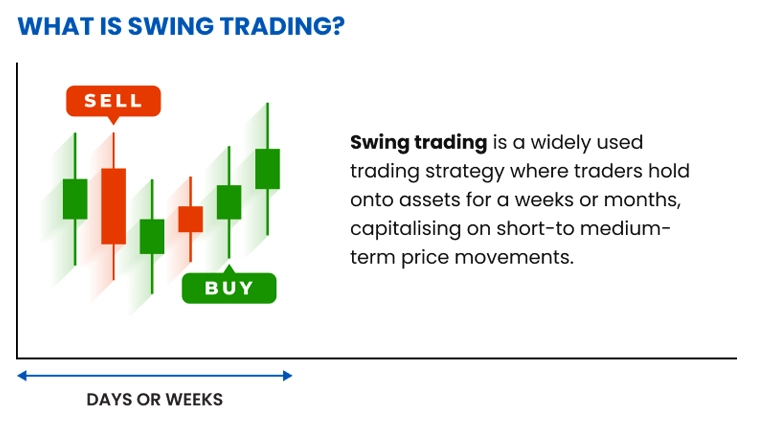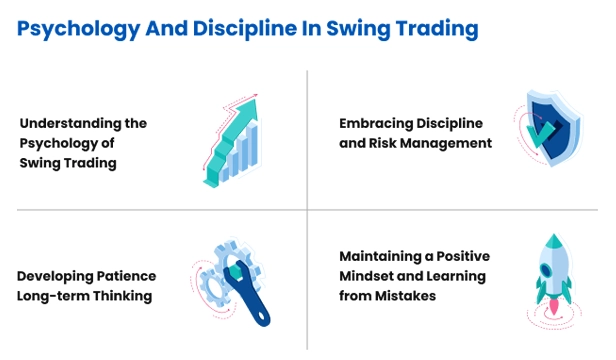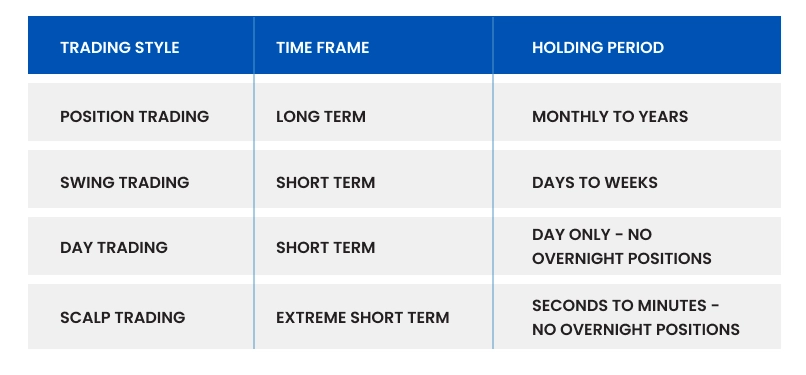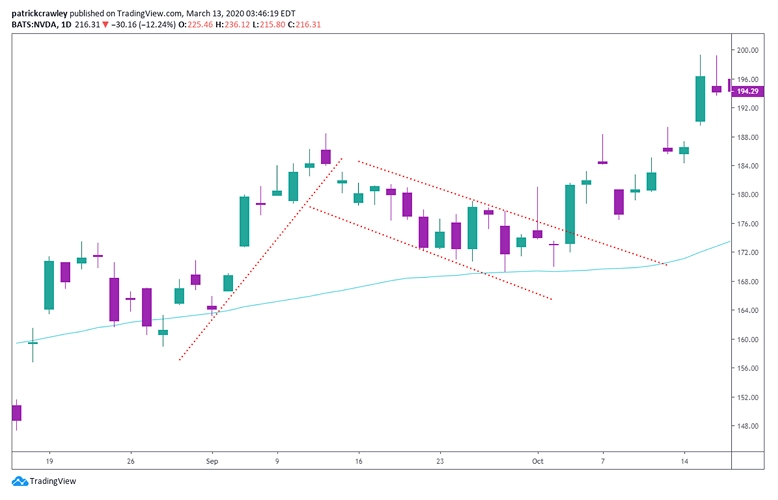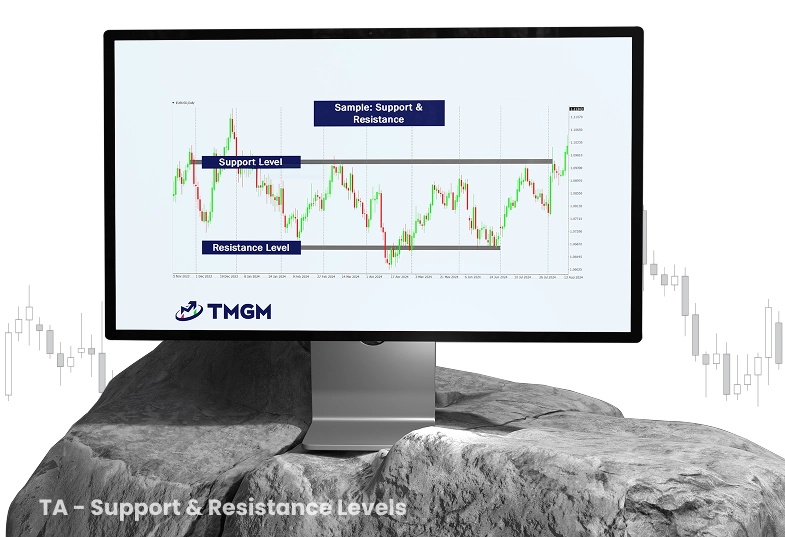

What is Swing Trading & How does it Work?
Swing trading is a popular trading style for traders seeking to trade with a less intensive trading style. It captures medium-term market movements without the intensity of day trading. By focusing on price swings over several days to weeks, you are essentially dealing with market trends rather than clicks, it allows traders to capitalize on market trends with minimal screen time, making it easier for those with other commitments or simply beginners.
Key Takeaways
- Swing trading targets several days to weeks' price swings to ride a trend with lesser screen time, and often larger price swings than day trading, balancing flexibility with structured risk control.
- The key to successful & profitable swing trading depends on patience to let setups play out and discipline to follow predefined exits, reducing impulse trading and emotional overreactions.
- Compared to scalping, day, and position trading, swing trading uses at least 4-hour to daily charts to seek larger moves with lesser monitoring and trading frequency.
- Benefits of Swing Trading include time efficiency, lower costs, and capturing bigger price legs, while drawbacks include gap risk, tied-up capital, and strategy sensitivity to market regime.
- Beginner-friendly strategies include bull flags, support/resistance bounces, moving-average crossovers, Fibonacci pullbacks, and breakouts validated by range structure and volume.
- Risk control centers on position sizing (often 1–2% per trade), ATR- or level-based stops, favorable reward-to-risk ratio, and partial profit-taking or trailing stops.
- Best Indicators for Swing Trading include volume tools (OBV, Volume Profile, Chaikin), momentum oscillators (RSI, Stochastic, MACD), and trend gauges (EMAs, ADX, Ichimoku).
- A good swing trading plan defines market trends, timeframes, entry/exit rules, sizing, and review cadence, supported by backtesting metrics and a detailed trading journal for continuous refinement.
- Getting started on a broker platform like TMGM means practicing on a demo, using risk controls and education tools, and applying swing rules consistently before scaling live.
What Is Swing Trading? Swing Trading Meaning Explained
Figure 1: Explaining swing trading as a trading strategy where traders hold onto assets for days, weeks, or months, capitalizing on short- to medium-term price movements
Swing trading is a form of trading style that aims to capture gains in security for several days to several weeks. Unlike day trading strategies, where the trading style dictates that positions are opened and closed within the same trading day, swing trading allows for overnight and weekend position holding. Still, unlike position trading or investing, it doesn't involve holding assets for months or years.
The best time frame for swing trades ranges from 2 days to several weeks. This is an ideal approach for traders who can't monitor markets constantly but still want to capitalize on market movements and benefit from market swings while filtering out the noise of intraday fluctuations.
Swing traders ride the momentum of a trend (often up to 20-30%) for a significant portion of its duration, rather than just a small portion of it. These swings will take time to manifest, typically coming in waves with consolidations and retracements.
The Psychology Behind Swing Trading
Successful swing trading requires a balanced psychological approach, similar to the discipline needed in margin trading. On one hand, swing traders need the patience to allow trades to develop according to their analysis. On the other hand, they must be disciplined enough to take profits or cut losses according to predetermined levels.
The psychological advantage of swing trading is that it reduces the pressure of making split-second decisions. With more time to analyze setups and manage positions, traders can maintain clearer thinking and avoid the emotional pitfalls that often plague day traders, such as revenge trading or overtrading.
Figure 2: Highlights the key psychological and discipline-related factors necessary for successful swing trading
Swing Trading vs. Other Trading Styles
To understand swing trading better, it helps to compare it with other popular trading styles:
Figure 3: A side-by-side chart comparing day different trading styles, monitoring, capital, and market approach
Day traders open and close positions within the same day
Swing traders hold positions for days or weeks
Day trading requires constant market monitoring; swing trading requires periodic checking
Day traders typically use 1-minute to 1-hour charts; swing traders use 4-hour to daily charts
Position Trading vs. Swing Trading:
Position traders hold trades for months or years
Swing traders exit positions once the swing has been completed (days to weeks)
Position traders focus more on fundamental analysis; swing traders rely more on technical analysis
Position trading requires less frequent monitoring than swing trading
Scalping vs. Swing Trading:
Scalpers aim to profit from very small price movements, often holding for seconds to minutes
Swing traders capture larger market moves
Scalpers may make dozens of trades daily; swing traders make fewer, more selective trades
Scalping requires intensive focus and specialized execution tools; swing trading can be done with standard trading platforms
Pros and Cons of Swing Trading
Advantages of Swing Trading
1. Time Efficiency
Swing trading requires less time commitment than day trading. The original document highlights that "Swing traders can achieve reasonably similar returns to day traders in less time. Because their trades take days to unfold, they aren't required to sit at their screens, watching each tick go by." This time efficiency makes swing trading ideal for those balancing trading with other commitments. You don't need to monitor charts tick by tick, which creates a healthier work-life balance and reduces the risk of burnout that many day traders experience.
2. Reduced Risk of Overtrading
With less screen time, swing traders are less tempted to overtrade. The original text notes, "Because of spending less time staring at markets, swing traders are likely less tempted to overtrade. They're not continually thinking out their trades all day the way that day traders do, and some day traders get addicted to being in a trade and will take suboptimal trades just to 'be in a trade.'" This psychological advantage helps maintain discipline and prevents the emotional trading decisions that often lead to losses.
3. Lower Transaction Costs
Swing traders execute fewer trades, resulting in lower commission costs and reduced impact from slippage compared to more frequent trading styles. The source material confirms, "Swing traders also pay fewer commissions, fees, and slippage, and these fees have a smaller impact on their trades because their profits are larger per trade." Over time, these cost savings can significantly impact overall profitability, especially for traders with smaller accounts.
4. Better Work–Life Balance
Unlike day trading, which can consume entire days, swing trading allows for a more balanced lifestyle. Traders can maintain full-time jobs, spend time with family, or pursue other interests while still actively participating in the markets. This sustainability makes swing trading a viable long-term approach for many traders.
5. Captures Substantial Market Moves
Swing trading is designed to capture meaningful price movements. As the document states, "While day traders usually look to capture one piece of a more significant move, swing traders try to capture an entire leg or swing upwards/downwards." This approach allows traders to benefit from the meat of price movements rather than just small fragments.
Disadvantages of Swing Trading
1. Overnight Risk Exposure
Swing traders are exposed to overnight and weekend risk, including gap openings due to unexpected news or events that occur when markets are closed. The original text emphasizes this point: "Those of you trading the markets amid this Coronavirus pandemic know how serious overnight risk is right now, on both the long and short side. A swing trader cannot mitigate the effects of overnight risk, at least in individual stocks. Day traders can swiftly flatten their position at any time." This risk requires additional risk management considerations, sometimes leading to losses beyond intended stop levels.
2. Missing Intraday Opportunities
While day traders can capitalize on multiple opportunities within a single trading day, swing traders might miss these short-term movements. Market “trend days”—sessions characterized by sustained, high-conviction directional moves—happen regularly. During these periods, swing traders who align with the prevailing trend often capture sizable gains, while day traders can exploit multiple intraday opportunities using proven day trading strategies like scalping and momentum trading. This limitation means missing profitable short-term trading opportunities that don’t develop into larger moves.
3. Requires Patience and Discipline
Swing trading demands the patience to let trades develop over days or weeks, which can be challenging for traders accustomed to the immediate feedback of day trading. The psychological strain of holding positions through drawdowns and waiting for target levels requires significant emotional discipline.
4. Capital Tied Up Longer
Because positions are held longer, capital is tied up in fewer trades. This reduced capital efficiency can limit opportunities, especially for traders with smaller accounts who might be unable to enter new positions while waiting for existing trades to play out.
5. Market Environment Dependence
Swing trading strategies perform differently in various market environments. Trend-following approaches work well in trending markets but may generate false signals in choppy, range-bound conditions. Adaptability is essential, as strategies that worked in previous market regimes may underperform in new conditions.
Essential Swing Trading Strategies for Beginners
Bull Flag Pattern
The bull flag is one of swing traders' most reliable chart patterns under swing trading strategies. As the name suggests, the pattern resembles a flag on a pole when plotted on a chart. This pattern represents a brief pause in a strong uptrend, allowing traders to enter before the next leg higher.
Figure 4: Candlestick chart from TradingView illustrates a bull flag pattern, a common continuation pattern used in swing trading common continuation pattern used in swing trading
Key Characteristics of Swing Trading:
A sharp upward movement (the flagpole) on high volume, typically a 30-100% price increase
A consolidation period with a slight downward drift (the flag), usually retracing 1/3 to 1/2 of the flagpole
Lower volume during the consolidation phase (ideally 50% or less of the pole volume)
A breakout above the flag pattern, signaling entry
The pattern typically forms over 1-4 weeks
The source material states, "A bull flag is a trend pullback setup. The setup got its name because it looks like a flag when you trace the price action. The pattern is one of the more conservative trading patterns. Trend pullbacks, while probably being the most accessible type of pattern to trade and having the best odds of continuation, aren't the most exciting trades. They're typically retracements of the recent swing high."
Trading the Bull Flag Pattern:
Identify the Setup: Look for a strong upward move followed by a consolidation period
Confirm Volume Pattern: Heavy volume on the pole, lighter volume on the flag
Entry: Enter on a breakout above the upper trendline of the flag with increased volume
Stop Loss: Place stop loss below the lowest point of the flag
Target: Measure the length of the flagpole and project it from the breakout point
The original document emphasizes the key characteristics: "The most successful bull flag patterns tend to have similar characteristics, those being: A sharp impulse move higher on high volume, forming the flag pole; The stock pulls back a bit, in a less aggressive fashion than the pole's descent upwards; The break of the flag is a signal to enter a long position."
The best bull flag setups typically appear in the following:
Stocks that have recently reported strong earnings (20%+ surprises)
Leading stocks within strong sectors (outperforming sector by 10%+)
Market leaders like Apple or Microsoft in recent bull markets
Stocks making new 52-week highs
Each trading day surfaces hundreds of bull flag patterns, so it’s essential to zero in on the highest-probability setups. The most profitable bull flag trades combine strong volume and momentum during the initial surge, followed by muted volume and momentum during the pullback. To further refine your bull flag trading strategy, prioritize:
Stocks reporting a significant earnings beat
Companies in leading sectors that are outperforming their peers
Market leaders—recent examples include tech giants like Apple and Microsoft
Support & Resistance Trading Strategy & Techniques
Support and resistance levels offer excellent entry points for swing traders, mainly when trading in the direction of the prevailing trend. These psychological price levels represent areas where buying or selling pressure has previously halted price movements.
Figure 5: Highlights the support and resistance levels in trading, key concepts in technical analysis that help traders identify potential entry and exit points
Types of Support & Resistance Levels:
Types of Support and Resistance:
Horizontal Support & Resistance Levels: Price points where the market has repeatedly reversed
Dynamic Support & Resistance Lines: Moving averages that act as floating support/resistance
Psychological Price Levels: Round numbers (e.g., $50, $100) that influence trading decisions
Fibonacci Retracement Levels: Mathematical retracement levels based on prior moves
Prerequisites for Effective Support/Resistance Trading:
The stock must be in a clear trend (uptrend for buying at support, downtrend for selling at resistance)
The support or resistance level should be well-defined with multiple touches
Volume should confirm the level's significance (higher volume at bounces)
Implementation Tips:
Focus on leading stocks within leading sectors
Look for stocks showing higher highs and higher lows (for uptrends)
Pay attention to momentum indicators – avoid buying when momentum makes new lows
Consider placing buy stops above range highs after low-momentum pullbacks to support
The more times a level has been tested, the more significant it becomes
Look for a confluence of multiple support/resistance factors at the same price level
Risk Management Tips:
Enter trades when price approaches support (in uptrends) or resistance (in downtrends)
Place stop losses beyond the support/resistance level (allowing for some "wiggle room")
Take partial profits at the next resistance level (when buying at support)
Moving Average Crossovers
Moving average crossovers are a fundamental swing trading strategy that helps identify shifts in market momentum and trend direction. This approach uses two or more moving averages of different periods to generate buy and sell signals.

Figure 6: Showcases the 50-day Simple Moving Average (SMA), a widely used trend-following indicator in trading
Popular Moving Average Combinations:
10 and 20-day EMAs (fast crossover system)
20 and 50-day EMAs (medium-term signals)
50 and 200-day SMAs (the famous "Golden Cross" and "Death Cross")
Trading Rules:
Buy Signal: When the shorter-term MA crosses above the longer-term MA
Sell Signal: When the shorter-term MA crosses below the longer-term MA
Confirmation: Look for volume increase and candlestick patterns to confirm the crossover
Advanced Swing Trading Techniques:
Use three moving averages (e.g., 5, 10, and 20-day) for stronger confirmation
Add a longer-term MA (e.g., 200-day) to identify the primary trend direction
Look for moving average "compression" (MAs converging) before breakout moves
Fibonacci Retracement Levels
Fibonacci retracement levels help swing traders identify potential reversal points during a price correction. These levels (23.6%, 38.2%, 50%, 61.8%, and 78.6%) are based on the Fibonacci sequence and often act as support or resistance.
Figure 7: Demonstrates the Fibonacci retracement levels, a widely used technical indicator for identifying potential support and resistance zones in trading
How to Use Fibonacci Retracements:
Identify a significant price move (swing low to swing high for uptrends)
Draw the Fibonacci retracement tool from the start to the end of the move
Watch for price reactions at the key retracement levels
Enter trades when the price bounces off retracement levels in the direction of the original trend
Best Practices:
The 38.2% and 61.8% levels are often the most reliable retracement levels
Look for confluence with other technical indicators (moving averages, trendlines)
Use candlestick patterns at retracement levels to confirm reversals
Combine with momentum indicators to gauge the strength of the retracement
Breakout Trading Strategy
Breakout trading involves entering positions when the price breaks through significant support or resistance levels, capitalizing on the momentum that often follows. This strategy is commonly used in volatile markets where price consolidations lead to strong directional moves.
Key Breakout Patterns
Some of the most recognized breakout formations include:
Rectangle Patterns: Price moves within a horizontal range before breaking out.
Triangle Patterns: Ascending, descending, or symmetrical triangles indicate potential breakouts in the direction of the trend.
Head and Shoulders: A bearish reversal pattern signaling a potential downward breakout.
Cup and Handle: A bullish continuation pattern often leads to a breakout to the upside.
Breakout Trading Approach
To effectively trade breakouts, traders should:
Identify a well-defined consolidation pattern, ensuring the breakout level is clear.
Monitor volume, as increasing volume can confirm strong momentum.
Enter the trade once the price breaks through resistance (for longs) or support (for shorts) with conviction.
Place stop-loss orders below the breakout level (for long trades) to limit risk.
Set profit targets at the next significant resistance or by measuring the previous price range.
Avoiding False Breakouts
False breakouts occur when the price moves beyond a key level but quickly reverses. To minimize this risk:
Wait for confirmation, ensuring the price closes beyond the breakout level.
Check for above-average volume to validate the breakout’s strength.
Use the 2% rule, ensuring the price moves at least 2% beyond the breakout level before entering.
Trade with the trend, avoiding breakouts against the broader market direction.
By combining technical confirmation with sound risk management, breakout traders can improve their probability of success while avoiding common pitfalls.
Risk Management for Swing Traders
Effective risk management is crucial for long-term success in swing trading. Even the best strategies will experience losses, and protecting your capital during these inevitable drawdowns separates successful traders from those who blow up their accounts.
Position Sizing Strategy
Position sizing determines how much capital you allocate to each trade, and it's one of the most important aspects of risk management.
Key Position Sizing Approaches:
Fixed-Percentage Risk Models: Risk a fixed percentage (typically 1-2%) of your total trading capital on each trade
Volatility-Based Position Sizing: Adjust position size based on the volatility of the instrument (smaller positions for higher volatility)
Tiered Position Sizing Methods: Allocate different percentages based on conviction level (e.g., 0.5% for moderate conviction, 1% for high conviction)
Calculation Example: If you have a $10,000 account and want to risk 1% per trade:
Maximum risk per trade = $100
If your stop loss is $0.50 away from entry on a stock, you can buy 200 shares ($100 ÷ $0.50)
As your account grows or shrinks, adjust your position sizes accordingly
Setting Stop Losses
Stop losses and protect your capital by automatically exiting trades when they move against you beyond a predetermined point.
Effective Stop Loss Placement:
Technical Stop-Loss Orders: Place stops below significant support levels (for long positions) or above resistance (for shorts)
Volatility-Based Stop-Loss Orders: Use Average True Range (ATR) to set stops based on market volatility (e.g., 2 × ATR below entry)
Time-Based Stop-Loss Orders: Exit trades that haven't performed as expected within a certain timeframe
Stop-Loss Best Practices:
Effective stop-loss management is crucial for controlling risk and improving trade consistency. Following these best practices can help traders protect capital and enhance trade execution:
Always set stops at the time of entry: Placing a stop loss immediately ensures discipline and prevents emotional decision-making during volatile market conditions.
Avoid obvious stop levels: Setting stops at well-known support or resistance levels can make them vulnerable to stop hunts, where the price briefly moves to trigger orders before reversing. Consider placing stops slightly beyond these levels to reduce the risk of premature exits.
Use mental stops in high volatility: In exceptionally volatile markets, using mental stops instead of fixed stop-loss orders can help avoid getting "stopped out" due to temporary price spikes. However, this requires strong discipline and real-time monitoring.
Never move stops further away: A stop-loss should act as a safeguard, not a moving target. Traders should only adjust stops to lock in profits, never to increase risk exposure.
By following these best practices, traders can maintain structured risk management while adapting to market conditions.
Profit Target Technique for Swing Trading
Having predetermined profit targets helps maintain discipline and avoid the emotional pitfalls of managing winning trades.
Profit Target Methods:
Technical Chart Levels: Exit at key resistance levels (for longs) or support levels (for shorts)
Risk Reward Ratio: Set targets at a 2:1 or 3:1 distance from your entry compared to your stop loss
Trailing Stop-Loss Techniques: Use trailing stops to lock in profits while allowing winners to run (e.g., 2 × ATR trailing stop)
Partial Profit-Taking Strategies: Scale out of positions by taking partial profits at different levels
Technical Indicators for Swing Trading
While price action should be the foundation of your analysis, technical indicators can provide valuable additional insights for swing trading decisions.
Essential Volume Indicators
Volume confirms price movements and can help identify the strength behind trends and reversals.
Essential Volume Indicators:
Volume Bars Analysis: Basic volume representation showing trading activity
On-Balance Volume (OBV) Indicator: Cumulative indicator that adds or subtracts volume based on price direction
Volume Profile Analysis: Shows volume distribution at different price levels
Chaikin Money Flow Indicator: Measures buying and selling pressure over a specific period
How to Use Volume:
Volume is a key technical indicator that provides insights into the strength and sustainability of price movements. Understanding volume trends can help traders confirm breakouts, identify potential reversals, and anticipate trend shifts.
Confirming Breakout Signals: Increasing volume on a breakout suggests strong participation and a higher likelihood of trend continuation. A breakout with low volume may lack conviction and be more prone to failure.
Avoiding Low-Volume False Breakouts: Price movements on declining volume can indicate weak momentum, suggesting the trend may be losing strength or preparing for a reversal.
Recognizing Volume Spikes: Sudden volume surges often signal market exhaustion, where the current trend is reaching an extreme. This can lead to a potential reversal or short-term correction as buying or selling pressure fades.
Spotting Price-Volume Divergences: If the price makes new highs or lows while volume declines, it may indicate weakening trend strength and a potential trend reversal ahead.
By incorporating volume analysis into trading strategies, traders can improve decision-making and reduce the likelihood of false signals.
Momentum Oscillators
Momentum oscillators help identify overbought and oversold conditions, potential reversals, and trend strength.
Key Momentum Indicators:
Relative Strength Index (RSI) Indicator: Relative Strength Index (RSI) is a momentum indicator used in technical analysis to assess overbought or oversold conditions in financial markets by measuring the speed and change of price movements on a scale of 0-100
Stochastic Oscillator: Compares a security's closing price to its price range over a specific period
MACD (Moving Average Convergence Divergence): MACD is a technical indicator that helps investors identify price trends, measure trend momentum, and identify entry points for buying or selling.
Rate of Change (ROC) Indicator: Measures the percentage change in price over a specified period
Trading Applications:
Look for divergences between price and momentum indicators (price makes a new high while RSI makes a lower high)
Use oversold readings (RSI below 30) to find potential buying opportunities in uptrends.
Use overbought readings (RSI above 70) to find potential shorting opportunities in downtrends.
Confirm trend changes with crossovers (MACD line crossing signal line)
Trend Following Indicators
Trend-following indicators help identify the direction and strength of the prevailing market trend.
Popular Trend Indicators:
Moving Averages (SMA & EMA): Show the average price over a specific period
ADX (Average Directional Index): Measures trend strength regardless of direction
Parabolic SAR Indicator: Identifies potential reversals in price direction
Ichimoku Cloud Overview: Comprehensive indicator providing support/resistance, trend direction, and momentum
Indicator Implementation Strategies:
Use 20 and 50-day EMAs to identify medium-term trends
Consider ADX readings above 25 as strong trend signals
Look for prices staying consistently above/below key moving averages
Use Ichimoku Cloud for multiple confirmation signals
Creating Your Swing Trading Plan
Creating a structured swing trading plan is crucial for maintaining consistency and eliminating emotional decision-making. A well-defined strategy should outline key components such as market selection, timeframes, entry and exit criteria, position sizing, and trading hours. Traders must decide which markets or instruments to focus on, the chart timeframes for analysis, and the specific conditions required to enter and exit trades.
Swing Trading Strategy Example:
For example, a trader might concentrate on S&P 500 stocks with market capitalizations above $10 billion, using daily charts for trend identification and 4-hour charts for precise entry timing. A possible strategy could involve entering trades on pullbacks to the 20-day EMA in strong uptrends while using a 2:1 reward-to-risk ratio or a trailing stop set at twice the ATR.
Position sizing should align with risk management principles, such as limiting risk to 1% of the account per trade. Additionally, setting a structured routine—such as reviewing weekend watchlists and analyzing potential setups each evening—ensures traders stay prepared and disciplined in executing their plans.
Backtesting Your Approach
Backtesting allows traders to test their strategy on historical data before committing to real capital. By simulating trades under past market conditions, traders can assess effectiveness, identify weaknesses, and refine their approach.
The process involves defining clear strategy rules, gathering historical market data, and applying the strategy to past price movements. Key metrics to track include win rate, profit factor, maximum drawdown, and risk-adjusted returns (Sharpe ratio). Analyzing these results helps refine the strategy while avoiding overfitting, which can lead to unrealistic expectations in live trading.
By systematically backtesting, traders can gain confidence, enhance risk management, and improve decision-making before executing trades in real market conditions.
Maintaining a Swing Trading Journal
Keeping a trading journal is essential for tracking performance, similar to the practices outlined in our guide on how to trade cryptocurrency.
What to Record in Your Swing Trading Journal
Each trade should be documented with key details, including entry and exit prices, position size, and market conditions during execution. Traders should also capture screenshots of trade setups, note their entry rationale, and record any emotions experienced during the trade. Evaluating what worked well and what went wrong helps recognize behavioural patterns and refine decision-making.
Review Process:
A structured review process enhances learning and growth—this includes a weekly review of all trades, a monthly performance assessment, and quarterly strategy adjustments based on insights from the journal. By consistently maintaining and analyzing a trading journal, traders can develop greater discipline, improve their execution, and enhance long-term profitability.
Getting Started with Swing Trading at TMGM
Free Swing Trading Courses & Resources
Becoming a successful trader requires skill, knowledge, and practice. TMGM provides comprehensive trading courses and webinars to help you develop your expertise. A free demo account with US$100,000 in virtual funds allows you to practice trading in a risk-free environment and refine your strategies.
TMGM also offers trading strategy insights, TMGM Market News & Analysis and proprietary tools like Acuity, Economic Calendar and more, tailored for traders of all experience levels.
Trade Smarter Today




Frequently Asked Questions (FAQs) for What is Swing Trading?
What is Swing Trading?
Which strategy is best for swing trading?
What is the 2% rule in swing trading?
What is the 3-5-7 rule in trading?
How long does a swing trader typically hold a trade/position?


Account
Account
Instantly

